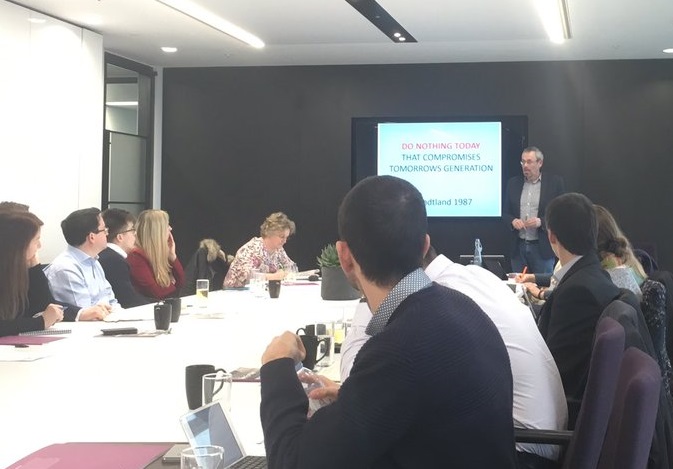On 31st January 2017 the Constructing Excellence Sustainability Theme Group explored healthy buildings and wellness. Chaired by Paul Toyne and hosted by Aecom – at their Aldgate Tower offices which has been designed to meet the very latest standards in healthy buildings and wellness, over 35 people across the whole value chain gathered to discuss the emergence of healthy buildings and what it might mean for their organisations.
The business case behind healthy buildings and investing in standards such as WELL, BREEAM and the Living Building Challenge, as well as the demand for healthy buildings and the practicalities of delivery in both new and existing buildings and future implications for regulations and law were explored.
Here are the top things we learnt during the workshop:
- Changing buildings is a great opportunity to instigate healthy changes
Dave Cheshire from Aecom looked at how making making healthier choices easier for employees could help make them healthier, more productive and more resilient to stressful life and work events. Aecom are implementing solutions to encourage people to live well, both for their own staff and on client projects. - Take the investment conversations up a level
Dave’s top tip for making the business case was to take the conversation up a tier to those who have a more holistic view of the business investments. Engaging the Human Resources department at can help justify expenditure that might add cost to the capital budget but will save significant amounts over the long term occupation of the building. - Circadian rhythms – mimicking nature
As part of the British Antarctic Survey project Aecom looked at how intelligent lighting solutions could mimic natural daylight patterns in order to trigger the hormones that set our natural body clock. This is particularly important in a building where it’s pretty dark for six months of the year, however this learning can equally be applied to night workers or office buildings where natural light doesn’t penetrate deep into the building floor plates. - People don’t always understand the risks
Isabella Myers gave a public health perspective on the link between buildings and health and wellbeing. She flagged up the risks of delivering interventions when occupants were often resistant to changes and not necessarily convinced of the risks to their health from problems such as leaky boilers and fuel combustion. This can come in many forms including deaths from carbon monoxide and neuropsychiatric symptoms from long term exposure to toxins. - Our strategies to save carbon may have made it worse
Isabella reminded us that some of the strategies that have been employed to save energy and carbon dioxide have led to more airtight homes and buildings have caused the build-up of toxins that can impact people’s health. - Healthy Buildings attract premium tenants
Anita Mitchell Head of Sustainability for Lendlease Europe spoke about increasing market demand for healthy buildings. On a recent project in Sydney major clients in the financial services and blue-chip companies were demanding high levels of WELL Buildings Standard. Eventually this could lead to devaluing property that does not support health and wellbeing. - Speculative developments can still be healthy
The strategy to deliver WELL-Ready core and shell schemes enables tenants to implement their own health and wellbeing strategies in order to meet the WELL Building Standard. - Health & Wellbeing cuts across the political divide
Health and wellbeing impacts on social and economic sustainability, therefore both sides of the political divide can support the agenda, on the one hand it benefits society and on the other it delivers bottom-line economic benefits. - Don’t forget the construction process
Martin Brown from Fairsnape reminded us that whilst the end product needs to support wellbeing there is a requirement not to forget how the built environment is constructed, the toxicity of materials used and the people who build them. While we have made huge progress in terms of onsite health and safety, the industry has one of the highest mental health and suicide rates after agriculture. - Biomimicry
There is a lot we can learn from nature and how it functions in order to reproduce natural patterns and deliver healthier and better performing buildings. For example the Living Building Challenge certified Bullitt Centre in Seattle mimics the effect of a tree canopy to limit exposure to overheating and solar glare. - Data can help
By mapping physical data sets from BIM with biological datasets from the health sector and fitness trackers etc. a really rich picture of how buildings and the built environment are impacting on people’s health and wellbeing is emerging, and providing data for health improvement. There are lots of ways in which existing buildings can be improved to increase the health and wellbeing of the occupants. BRE is carrying out a research project on a real life Biophillic office refurbishment assessing the health and wellbeing of occupants before and after various interventions. - WELL & BREEAM are setting the standard
BREEAM and WELL have been working together to establish common factors and areas of mutual recognition for elements of their respective standards. Chris Ward provided an overview of progress including an initial mapping exercise that has been published in a technical guidance document.This will lead to further collaborative work to ensure that health and wellbeing are an even more integral part of the BREEAM standard going forward.
The group will meet again in April to look at how innovative, healthy and sustainable materials are being specified and how that process can be improved to ensure that clients and specifiers increase their understanding and demand innovative products and materials.
Download the presentations:
Working Well – A multi-disciplinary perspective, Dave Cheshire, Aecom
[slideshare id=72233158&doc=aecomwellbeingceevent-170216153320]
The developer perspective, Anita Mitchell, Lendlease
[slideshare id=72233618&doc=wellbeing-adevelopersperspective-170216154340]
FUTURESTORATIVE, Martin Brown, Fairsnape
[slideshare id=72262141&doc=cesustgroupfuturestorativelite150-170217084610]
BREEAM & WELL Buildings Standard, Chris Ward, BREEAM
[slideshare id=72233454&doc=breeamwellalignment310117-170216154012]


Comments are closed.